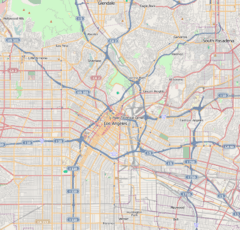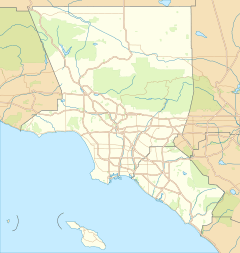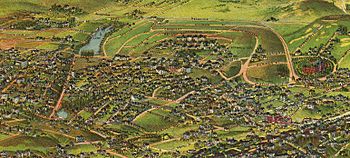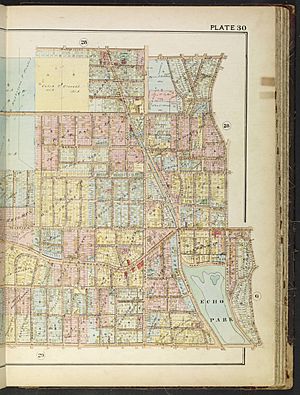Echo Park facts for kids
Quick facts for kids
Echo Park
|
|
|---|---|
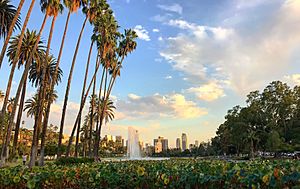
Echo Park Lake, with the Downtown Los Angeles skyline in the background
|
|
| Country | |
| State | |
| County | Los Angeles |
| City | Los Angeles |
| Elevation | 120 m (394 ft) |
| Time zone | UTC-8 (PST) |
| • Summer (DST) | UTC-7 (PDT) |
| ZIP Code |
90026
|
| Area code(s) | 213, 323 |
Echo Park is a lively neighborhood in the central part of Los Angeles, California. It's located northwest of Downtown, with Silver Lake to its west and Chinatown to its east. This area is known for its many different cultures. It's also a popular spot for artists, musicians, and other creative people. The heart of the neighborhood is the beautiful Echo Park Lake.
Contents
History
Early Film History in Edendale
Long before Hollywood became famous for movies, the Edendale area of Echo Park was a major center for filmmaking on the West Coast. This started around 1892.
By the 1910s, many film studios were busy along what is now Glendale Boulevard. These included Selig Polyscope Company, Mack Sennett's Keystone Studios, and Pathe West Coast Film Studio.
Famous silent film stars worked in these Edendale studios. Some of them were Fatty Arbuckle, Harold Lloyd, Mabel Normand, and Gloria Swanson. Charlie Chaplin made his very first film at Keystone Studios. The first full-length comedy movie, starring Chaplin and Normand, was also made there.
The first "pie-in-the-face" scene, a classic comedy trick, was filmed at what became the Mack Sennett Studios. This studio building, built in 1909, is now a historic landmark.
Echo Park Lake's Story
Echo Park Lake was created in 1868 as a reservoir to hold drinking water. It was filled with water from the Los Angeles River. In 1891, the land owners around the reservoir gave 33 acres to the city. They wanted it to be used as a park.
The city started working on the park in October 1892. The park superintendent, Joseph Henry Tomlinson, named it "Echo Park" because he heard echoes during its construction. By 1895, the park and a boathouse were finished. In the late 1910s, movie companies even used the park for filming.
In 2006, the lake was identified as needing a cleanup. The city spent $64.7 million to fix it up. The lake was closed and drained in 2011 for this big project. It reopened on June 5, 2013, after a $45 million renovation. The lake is a popular spot for the community.
Transportation
Glendale Freeway
The Glendale Freeway (SR 2) was planned in 1959 to connect with the Hollywood Freeway. However, it stops about 1.5 miles short of its planned end. This happened because people living in the area didn't want the freeway to go through their neighborhood.
Because of this, traffic from the freeway now goes through local streets like Glendale Boulevard and Alvarado Street. This can cause traffic jams. There have been ideas to turn the unused part of the freeway into a public park.
Pacific Electric Railway (Red Cars)
The Pacific Electric Railway, also known as the Red Cars, used to run through Echo Park. These electric trolleys started in the early 1900s and created a huge network of rails. They connected cities across Los Angeles and other counties. It was one of the largest public transit systems in the world at that time.
The Red Car system was eventually sold. The Los Angeles-Glendale-Burbank Line, which went through Echo Park, stopped running on June 19, 1955.
Geography
Echo Park has many rolling hills and valleys. It also has some flat areas, like Echo Park Lake. The main shopping and business streets are Sunset and Glendale boulevards.
Location in Los Angeles
Echo Park is located in Central Los Angeles, between Hollywood and Downtown Los Angeles. It is close to major freeways like the 101, the 2, and the 5.
Echo Park is surrounded by other neighborhoods:
- Elysian Valley to the north and northeast.
- Elysian Park to the east.
- Chinatown and Downtown to the southeast.
- Westlake to the southwest and west.
- Silver Lake to the northwest.
Climate
Echo Park has a hot-summer Mediterranean climate. This means it has warm, dry summers and mild, wet winters. The temperatures are very similar to those in Downtown Los Angeles.
| Climate data for Echo Park, Los Angeles | |||||||||||||
|---|---|---|---|---|---|---|---|---|---|---|---|---|---|
| Month | Jan | Feb | Mar | Apr | May | Jun | Jul | Aug | Sep | Oct | Nov | Dec | Year |
| Record high °F (°C) | 95 (35) |
95 (35) |
99 (37) |
106 (41) |
103 (39) |
112 (44) |
109 (43) |
106 (41) |
113 (45) |
108 (42) |
100 (38) |
92 (33) |
113 (45) |
| Mean maximum °F (°C) | 83.3 (28.5) |
84.3 (29.1) |
85.8 (29.9) |
91.2 (32.9) |
89.7 (32.1) |
90.2 (32.3) |
94.1 (34.5) |
95.3 (35.2) |
98.9 (37.2) |
95.5 (35.3) |
88.0 (31.1) |
81.4 (27.4) |
102.7 (39.3) |
| Mean daily maximum °F (°C) | 68.2 (20.1) |
68.6 (20.3) |
70.2 (21.2) |
72.7 (22.6) |
74.5 (23.6) |
78.1 (25.6) |
83.1 (28.4) |
84.4 (29.1) |
83.1 (28.4) |
78.5 (25.8) |
72.8 (22.7) |
67.7 (19.8) |
75.2 (24.0) |
| Daily mean °F (°C) | 58.0 (14.4) |
58.9 (14.9) |
60.6 (15.9) |
63.1 (17.3) |
65.8 (18.8) |
69.2 (20.7) |
73.3 (22.9) |
74.3 (23.5) |
73.1 (22.8) |
68.6 (20.3) |
62.4 (16.9) |
57.5 (14.2) |
65.4 (18.6) |
| Mean daily minimum °F (°C) | 47.8 (8.8) |
49.3 (9.6) |
51.0 (10.6) |
53.5 (11.9) |
57.1 (13.9) |
60.3 (15.7) |
63.6 (17.6) |
64.1 (17.8) |
63.1 (17.3) |
58.7 (14.8) |
52.0 (11.1) |
47.2 (8.4) |
55.6 (13.1) |
| Mean minimum °F (°C) | 41.3 (5.2) |
42.9 (6.1) |
44.9 (7.2) |
48.4 (9.1) |
53.6 (12.0) |
57.2 (14.0) |
61.2 (16.2) |
61.8 (16.6) |
59.2 (15.1) |
54.1 (12.3) |
45.0 (7.2) |
40.8 (4.9) |
39.1 (3.9) |
| Record low °F (°C) | 28 (−2) |
28 (−2) |
31 (−1) |
36 (2) |
40 (4) |
46 (8) |
49 (9) |
49 (9) |
44 (7) |
40 (4) |
34 (1) |
30 (−1) |
28 (−2) |
| Average rainfall inches (mm) | 3.12 (79) |
3.92 (100) |
2.43 (62) |
0.91 (23) |
0.26 (6.6) |
0.09 (2.3) |
0.01 (0.25) |
0.04 (1.0) |
0.24 (6.1) |
0.66 (17) |
1.04 (26) |
2.33 (59) |
15.05 (382.25) |
| Source: The Weather Channel | |||||||||||||
Neighborhood Districts
Echo Park has a few smaller areas within it:
Angelino Heights
Angelino Heights is famous for its beautiful old Victorian era houses. It sits at an elevation of about 502 feet.
Elysian Heights
Since the 1910s, Elysian Heights has been a home for many artists, writers, and filmmakers. It was also a place where children of many progressive thinkers went to school in the mid-20th century.
Population
Population Overview
In 2000, about 40,455 people lived in Echo Park. This means there were about 16,868 people per square mile, which is a very high number for Los Angeles. By 2008, the population had grown to an estimated 43,832. The average age of residents was 30.
Echo Park is known for its diverse population. In 2000, the breakdown was:
Many residents were born outside the U.S. (53%), mostly from Mexico (41.3%) and El Salvador (15.2%).
Household Information
In 2008, the average household income was $37,708. The average household had three people. Most homes (76%) were rented, while the rest were owned.
Many adults in Echo Park had never been married. In 2000, there were also many families led by single parents.
Parks and Recreation
Parks
Elysian Park
Elysian Park is one of the largest parks in Los Angeles, covering 600 acres. It's also the city's oldest park, created in 1886. While most of it is in the Elysian Park neighborhood, a small part extends into Echo Park.
- Angels Point: A small hill in Elysian Park with great views of Dodger Stadium and the Downtown Los Angeles skyline. It has a cool metal sculpture by artist Peter Shire.
- Chavez Ravine Arboretum: Opened in 1893, this arboretum has over 100 types of trees from all over the world. Some of these trees are believed to be the oldest and largest of their kind in the United States.
- Grace E. Simons Lodge: An event space with waterfalls and rooms for gatherings.
- Marion Harlow Memorial Grove: A small area with trees and plants along a hiking trail in Elysian Park.
Echo Park Lake
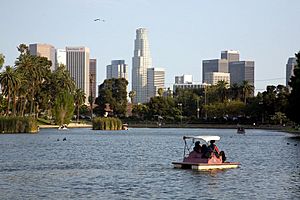
Echo Park Lake offers fun activities and is home to many animals. It has wetlands, which are important habitats. The lake hosts community events, like the yearly Lotus Festival in July.
- Boathouse and Paddle Boats: You can find a boathouse restaurant and many swan-shaped paddle boats to rent.
- Picnic Areas: There are picnic tables, BBQ pits, restrooms, and grassy areas for picnics.
- Walking Trail: A 1-mile paved path loops around the lake, perfect for walking.
Vista Hermosa Natural Park
Vista Hermosa Natural Park is a 10.5-acre urban park. It has walking trails, streams, meadows, and oak trees. You can also find picnic grounds and amazing views of the Downtown Los Angeles skyline. There's even a nature-themed playground.
Sports Facilities
- Chavez Ridge Disc Golf Course (in Elysian Park)
- Echo Park Deep Pool (an indoor swimming pool)
- Echo Park Recreation Complex, which includes:
- Lighted baseball diamond
- Lighted indoor and outdoor basketball courts
- Children's play area
- Community rooms
- 6 lighted tennis courts
- A stage
- Picnic tables
- An indoor gym
- A skate park (opened in 2020)
- Echo Park Youth Center
- Elysian Fields (two baseball diamonds in Elysian Park)
- Elysian Park Adaptive Recreation Center (in Elysian Park), which has:
- Outdoor basketball courts
- Children's play area
- Indoor gym (with weights)
- An amphitheater
- Classrooms
- A stage
- Vista Hermosa Synthetic Soccer Field (lighted)
Education
About 18% of adults in Echo Park (age 25 and older) have a four-year college degree. This is about average for the city.
Here are some of the schools in Echo Park:
Elementary Schools
- Baxter Montessori, 2101 North Echo Park Avenue (private school)
- Elysian Heights Elementary, 1562 Baxter Street (LAUSD). This school was famous for "Room 8" the cat!
- Clifford Street Elementary, 2150 Duane Street (LAUSD)
- Mayberry Street Elementary, 2414 Mayberry Street (LAUSD)
- Golden West Christian, 1310 Liberty Street (private school)
- Gabriella Charter, 1435 Logan Street (LAUSD)
- Logan Street Span School, 1711 West Montana Street (LAUSD) – serves students from kindergarten to 8th grade.
- Rosemont Elementary, 421 N. Rosemont (LAUSD)
- Betty Plasencia Elementary School, 1321 Cortez Street (LAUSD)
Other Schools
- DC Academy, 626 Coronado Terrace (private school)
Public Libraries
The Los Angeles Public Library has two branches in Echo Park:
- Echo Park Branch
- Edendale Branch
Entertainment and Night Life
Echo Park is known as one of Los Angeles's "hippest neighborhoods." It has many cool bars, nightclubs, and restaurants. The historic Taix French restaurant has been a landmark since 1964. Its 321 Lounge cocktail bar often has live music and comedy. It's also a popular spot for Los Angeles Dodgers fans before or after a baseball game.
Recently, two Echo Park restaurants were featured on the New York Times Restaurant List: Perilla LA (Korean-inspired) and Quarter Sheets (a pizzeria).
Notable People
- Veronica Porché Ali, psychologist and former wife of boxer Muhammad Ali.
- Carlos Almaraz, artist
- Austin Amelio, actor
- Conor Oberst, musician
- Allison Anders, film and television director
- Jackson Browne, musician
- Anna Camp, actress
- Charlie Chaplin, actor, comedian, composer, writer, film director.
- Frances Conroy, actress
- Alice Cooper, musician
- Jeffrey Davies, musician
- Lana Del Rey, musician, model, music video director.
- Mac DeMarco, musician
- Leonardo DiCaprio, actor
- William Ferguson (1822–1910), member of the Los Angeles Common Council
- Glenn Frey, musician
- Eric Garcetti, Los Angeles mayor
- Erica Garcia, Argentine rock singer-songwriter
- Seth Green, actor
- Kim Gruenenfelder, writer and congressional candidate
- Roy Hampton, Los Angeles City Council member, 1939–41
- Hand Habits, musician
- Marilyn Horne, soprano, lived at 1565 Altivo Way
- John Huston, film director
- Art Ingels, inventor of the Go-Kart
- Touko Laaksonen (AKA Tom of Finland), artist
- Paul Landacre, artist, lived at 2006 El Moran Street
- Sasha Lane, actress, model
- Shia LaBeouf, actor, writer, artist
- Solomon Lazard (1827–1916), entrepreneur, banker and politician
- Henry Jay Lewis, musical conductor
- Estelle Lawton Lindsey, newspaper columnist and Los Angeles City Council member, lived at 2414 Echo Park Avenue
- Edward Middleton Manigault, painter
- Aimee Semple McPherson, evangelist (created first megachurch)
- Steve McQueen, actor, lived on Vestal Avenue in 1955
- Carey McWilliams author, editor and lawyer
- Alessandro Nivola, actor, bought and lived in Angelino Heights Victorian home in 2002
- Molly Parker, actress
- Lil Peep, musician lived here from 2016 to his death in 2017
- Art Pepper, jazz musician
- Ariel Pink, musician
- Leo Politi, artist and illustrator
- James Wesley Potts, merchant, landowner and member of the Los Angeles Common Council; noted locally as an amateur weatherman nicknamed "The Prophet."
- Margaret Qualley, actress, dancer.
- Sara Ramirez, actress
- Ann Robinson, actress and stunt horse rider
- Horatio Sanz, comedian, actor, ex-SNL cast member and podcaster.
- Mack Sennett, writer, film producer, film director, studio executive
- Peter Shire, artist (80s Memphis Group postmodern pioneer)
- Sia, musician, writer
- Roger L. Simon, novelist and screenwriter. His fictional detective, Moses Wine, also lived in Echo Park.
- Grace E. Simons, a defender of Elysian Park
- Brando Skyhorse, author, lived on Portia Street
- Elliott Smith (1969–2003), musician, singer, songwriter
- JD Souther, musician
- Avey Tare, musician
- Darwin William Tate, Los Angeles City Council member, 1933–39
- Danny Trejo, actor
- Valentina, drag queen
- Clare Vivier, fashion designer
- Eric Wareheim, actor, comedian
- Clara Kimball Young, silent film actress
- Frank Zappa, musician and songwriter, lived at 1819 Bellevue Ave
- Jake Zeitlin opened an antique book shop at 1623 Landa Street
See also
 In Spanish: Echo Park (Los Ángeles) para niños
In Spanish: Echo Park (Los Ángeles) para niños


